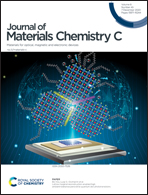Improved dielectricity of anisotropic wood slices and bioinspired micropatterned film electrodes for highly sensitive flexible electronic sensors†
Abstract
Taking inspiration and utilizing materials directly from nature, a simple and green strategy to fabricate biomass-based highly sensitive flexible tactile sensors was developed. Capacitive sensing devices were constructed by stacking a conductive micropatterned PDMS bottom electrode, an anisotropic wood slice/ionic liquid (IL@wood) dielectric layer and an unpatterned PDMS top electrode. After IL impregnation, the wood cross slice (CS) had an average weight gain rate (Rw) and an improved relative dielectric constant (εr) of 493.9% and 32.6, respectively, while those of the axial one were 82.1% and 6.6. The sensor made of an IL@wood cross (IL@CS) section and a lotus-leaf-like PDMS/silver nanowire (AgNWs@PDMS) film had a maximum capacitance value in the order of 100 μF cm−2 under 80 kPa compression, thereby exhibiting outstanding signal-to-noise ratio and responsive stability of the device. Its sensitivity reached 2.09 kPa−1 without obvious attenuation after 500 cycles. Additionally, it could not only monitor multiple motions including speaking, chewing and wrist bending but also decode handwriting and detect temperature variations.



 Please wait while we load your content...
Please wait while we load your content...